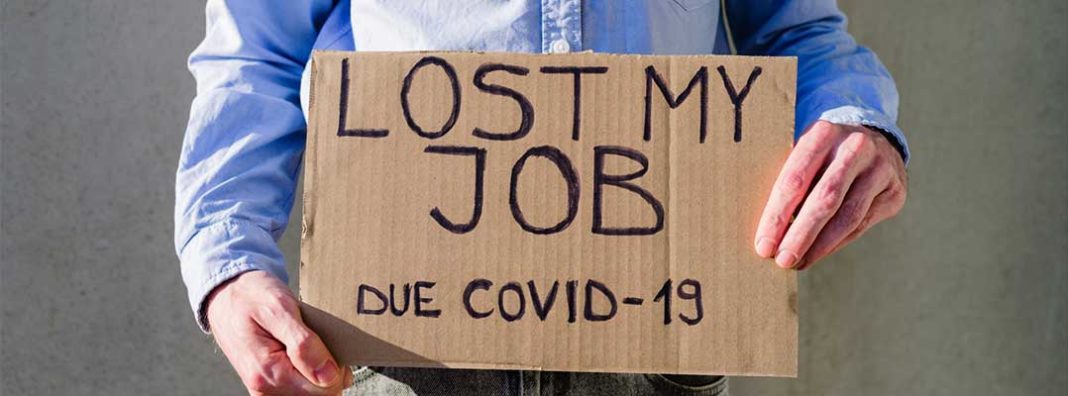
On Friday, the Bureau of Labor Statistics released new estimates for the number of Americans who are now jobless. The news isn’t good. Unemployment in America has now reached rates not seen since the Great Depression, with 14.5 percent of workers unemployed. These high levels of unemployment have largely been driven by the response to COVID-19. States across the country have ordered non-essential businesses to close in an effort to slow the spread of the virus. And although some states have begun to reopen, the reopening of America is going to be gradual.
Source: Slate
Federal policymakers have responded to these high levels of unemployment by both expanding unemployment benefits and sending direct cash payments to eligible Americans. Payments of up to $1,200 per adult and $500 per child have already been sent out to many households.
On Friday, three Democratic senators released the Monthly Economic Crisis Support Act, which would send $2,000 per month to every American who makes less than $100,000 a year. Those payments would be retroactive beginning in March and would last until three months after the public health emergency has been declared over. The bill’s estimated costs are astronomical at an estimated $1.8 — $3 trillion. Depending on where the actual number lands, that’s about 10 percent of overall US GDP.
Although $2,000 per month might not be the right amount, direct cash payments may be the most promising approach to the current crisis. Unconditional aid that provides money without strings attached allows people to spend the money how they see fit. On the other hand, conditional aid, which includes lots of stipulations, is also being tried in the form of expanded unemployment. But however well-intentioned, conditional aid programs tend to create many more unintended consequences than simply giving people money. These unintended consequences will slow economic recovery, making it harder for Americans to get back to work once the crisis is over.
Conditional aid messes with incentives
Unemployment insurance is a key piece of the U.S. safety net. One of the primary policy responses to the economic crisis spurred by COVID-19 has been to expand unemployment significantly. Congress passed the CARES Act in late March, giving states the ability to extend unemployment assistance to many who wouldn’t normally be eligible, including self-employed workers, those seeking part-time employment, and contractors. It also expands the time horizon so that unemployed workers can receive up to 39 weeks of benefits and increases the amount workers can receive by an additional $600 per week. That’s an extra $2,400 per month on top of regular unemployment benefits.
This dramatic expansion of unemployment is supposed to help workers stay afloat until the economy reopens, and more jobs are available. But even with greatly expanded eligibility, it’s proving difficult to get aid to those who need it most. State unemployment offices across the country are swamped with requests and unable to handle so many applications that don’t meet the typical requirements.
Perhaps the biggest problem with the current expansion of unemployment is that it may be creating unintended consequences that could slow the economic recovery. One of the goals of expanding unemployment insurances under the CARES Act is to maintain employer-employee relationships so that when the crisis is over, the economy will be able to start back up more quickly. With that goal in mind, the Paycheck Protection Program (PPP) provides loans to small businesses to help them get through the next few months and makes those loans forgivable if the business agrees to keep paying employees their pre-crisis wages (even those that may not be working). But the expansion in unemployment benefits means that some workers can now make more money through unemployment than by staying on the payroll at their current job.
A recent analysis by professors at Dartmouth and Wellesley College estimates that the typical ratio of unemployment benefits to pre-unemployment wages is about 50 percent for anyone making less than the maximum benefit. But the CARES Act expansion drastically boosted that ratio, changing the incentives that workers face. For those who make $10 an hour, current unemployment benefits are now double what they would otherwise make. Even those with higher salaries could be better off receiving unemployment. For example, in Mississippi, a worker making up to $43,680 per year would still be better off receiving unemployment under the current system than continuing to work. In Washington (a state with higher maximum benefits), a worker making up to $61,200 would be better off receiving unemployment.
Source: Econofact
All of this has created a Catch-22. Small business owners who take the PPP loans to stay afloat face an incentive to keep employees on so that their loans will be forgiven. By helping to maintain employer-employee relationships, this works toward the goal of allowing for a smoother recovery. But some workers who could make more through unemployment are asking to be laid off. For example, salon owner Jamie Black-Lewis received two small business loans through the PPP program to keep her salons afloat. In exchange for the promise of loan forgiveness, she agreed to keep paying her 35 employees. She was surprised when many of her employees told her they would rather be laid off so they could receive unemployment benefits. Black-Lewis summed up her predicament, “I couldn’t believe it. On what planet am I competing with unemployment?”
Conditional aid programs like unemployment insurance create real unintended consequences. Many workers can now make more money (in some cases much more) through unemployment than they currently make in their job. Who can blame them for being upset that the same law that expanded unemployment benefits is requiring their boss to keep them on the payroll so that a government loan will be forgiven? By damaging employer-employee relationships, this element of the CARES Act could make economic recovery post-COVID-19 that much more difficult.
Unconditional aid helps people without strings attached
In contrast to conditional aid like unemployment insurance, the key feature of unconditional aid is that it doesn’t punish or reward particular choices of workers. The direct cash payments through the CARES Act weren’t entirely stipulation-free (those making over the income threshold won’t be eligible for the whole amount), but they are unconditional in the sense that everyone under the income threshold will receive their payment and can use it as they see fit. They also won’t lose their payment if they decide to get a new job or start working part-time.
Some worry that giving people money without requiring them to meet some kind of work requirement will create incentives for currently employed workers to stop working or for the unemployed to stop looking for a job. But academic research suggests people aren’t likely to stop working if we give them cash.
In the U.S., researchers found that cash transfers from the Eastern Band of Cherokees Casino Dividend do not discourage work, but do increase educational attainment and improve mental health. Likewise, recipients of the Alaska Permanent Fund, which dispenses yearly payments averaging $1,000 — $2,000 to each Alaska resident did not work less as a result, but they did see higher birthweight among babies of low-income mothers.
Elsewhere in the world, the non-profit GiveDirectly has organized the transfer of $160 million in cash to more than 170,000 families living in poverty since its founding in 2009. Researchers found GiveDirectly’s cash transfer program in Kenya led to improved well-being and increased spending on livestock and metal roofs.
Cash transfer programs have also been tried in response to previous public health crises. In 2014, Ebola ravaged sub-Saharan Africa. In response to the Ebola crisis, cash transfer programs were implemented to offset the economic impacts in Sierra Leone and Liberia. A report by the Cash Learning Partnership found the payments improved food security led to the rebuilding of assets.
Unconditional aid is becoming increasingly popular in the wake of the current public health crisis. As of April 3, 2020, 71 countries have implemented cash transfer programs, with 54 new programs cropping up in response to COVID-19. Give Directly has likewise expanded its cash transfer programs both in Africa and in the U.S. in an effort to help those impacted by the COVID-19 crisis. These ongoing experiments will provide further evidence of the effectiveness of cash transfers to effectively deliver aid during a crisis.
Overall, research suggests that giving people cash is an effective way to help, both during a public health emergency and during more normal economic times. Rather than creating more conditional aid programs that encourage people to exit the labor force, we should focus on unconditional aid. Unconditional aid is more efficient, requires less bureaucracy to administer, and doesn’t attempt to dictate people’s decisions during a crisis. If we want fewer unintended consequences and more effective aid that helps people now, we should simply give people cash.


